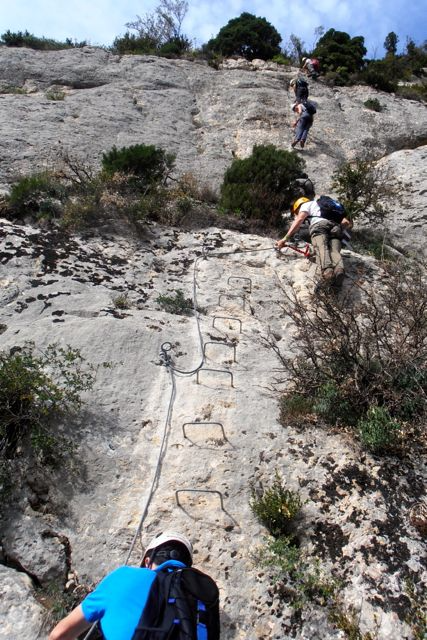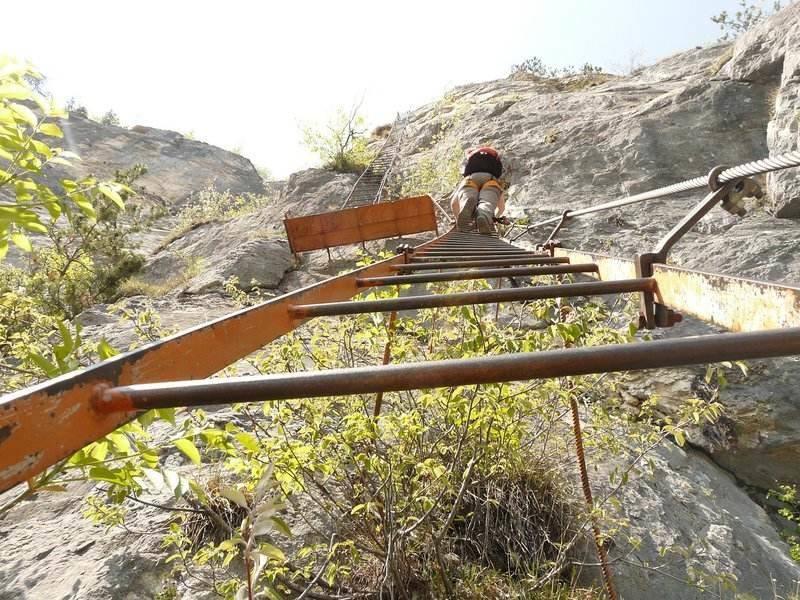Ever wondered what it’s really like to do a Via Ferratas in Spain? And what you need to know if you’re considering doing one?
Table of Contents
Read on…
First, let me explain what a via ferrata is. Many people have never heard of one. I hadn’t until I moved to Germany.
A via ferrata also called a Klettersteig in German. It is a steel cable fixed to the rock. You attach your harness to the steel cables and make your way up a rock face when rock climbing.
Depending on the Ferrata routes, there may be climbing aids. These can include iron rungs or steps carved into the rock.
At other times, your only climbing aid is your own agility and strength.

Related Reading: Self-Guided Coastal Hiking Tour from Catalonia, Spain to France.
Are Via Ferratas in Spain Difficult?

Via Ferratas in Spain, as elsewhere in the Alps are graded from A to E. A is the easiest. E has the most difficult level, even for experienced climbers.
You can find all levels of via Ferratas in Spain. So it really depends on the grade of the via Ferratas.
Don’t be fooled into thinking that via Ferratas in Spain can’t be as tough as the ones in the Alps as I was.
The level of difficulty should not be underestimated. The amazing mountain scenery is also one not to take lightly.
Related Reading: Catalonia Spain: Why You Need To Experience Adventure Here
A Short History of Via Ferratas

I am such an adventure lover. So when I had the chance to do a via Ferrata in Vallcebre, Catalonia, Spain I jumped at the opportunity without hesitation.
This is my element. I love hiking, scrambling, and beautiful views so much that you’ll find me in the German Alps almost every weekend. So this Ferrata excursion was a climbing experience I could not pass on.
I had only discovered the amazing views of via ferratas a couple of years ago. But I have loved the ones I’ve done. But to be honest, I didn’t have high expectations.
Via ferratas are mainly found in the Dolomites in Italy and Austria, with a few in Germany.
They were originally established to move soldiers across mountains in WWI. But in Catalonia, Spain? Obviously, this wouldn’t be a REAL one.
Related Reading: Best Wine Tours in Europe

My Experience of Doing a Via Ferrata in Spain
I was wrong. The most challenging part of my Ferrata experience was the first few steps.
That might not sound like a lot, but when your feet are slipping up the rock bringing your body down, it’s damn hard work.
Immediately, I cursed myself for not doing more push-ups. I tried again, and slipped, and slipped. And slipped yet again.
Becoming very frustrated, I undid my Via Ferrata harness and let someone else go in my place.
I could quit. And I had a good excuse. A recent surgery had left me feeling much weaker than normal. There’s no shame in acknowledging your limits – so feel free to throw in the towel when you need to.
But instinctively, I knew that it was within my limits. I gathered my inner strength and changed my mantra from I can’t to Of course I can.
Despite my shaky arms and running shoes with no grip, I was brave enough damn it! This mountain would not get the best of me.
I still slipped, but less so. And instead of moving backward, I was slowly but surely moving upwards.
Once I reached the first rung on the ladder, I breathed a sigh of relief. The toughest part was over….
or so I thought.
Recommended Reading: Where to Taste Wine in Europe: The Best Wine Tours in the Continent

I made my way steadily up the 90° ladder built into the wall. This was the easy part.
I caught up with the rest of the group and waited for them to move on.

While I was waiting, I started chatting with Miquel, a local who lived near Barcelona. He didn’t speak much English and I don’t speak much Spanish, but I liked him immediately.
He had a twinkle in his eyes and a smile that reached his eyes. A via Ferrata enthusiast for sure.
Tranquilo, tranquilo he would say to me while making a slow-down gesture with his hand. Tranquilo, tranquilo he said again during another difficult part while opening his arm to the incredible valley and mountainous terrain.
To be honest, I was so focused on the overhang that I had to get myself across using my almost non-existent upper body strength, I hadn’t even noticed the beautiful landscape for a moment.
His keen observation skills picked up on that. Watching him climb up slowly but steadily behind me, with a crinkly smile on his face, I get the feeling that he’s somebody who really knows how to enjoy life.
To enjoy being at the moment.
He saw me in my weakest, emotionally and physically tired state, but he didn’t encourage me. He didn’t say You can do it! Instead, more powerfully, he said Tranquilo, tranquilo.
He reminded me to take time to enjoy the journey – even the tough parts. Meeting Miquel was one of the highlights of my via ferrata.
Related Reading: Gaudi’s Barcelona: Architectural Marvels That You Must See.
Check out my friend Tony’s video of the via ferrata we did together in Vallcebre, Catalonia.
What You Need to Know Before Doing a Via Ferrata in Spain
Despite what I previously thought, vias ferratas in Spain can kick your butt, like the Via Ferrata La Guagua in Gran Canaria. Make sure your fitness level can endure the rock climbing experience.
We only did one that was ranked as medium difficulty, so a C-D level. Still, all of our group found it more challenging than anticipated.
Having said that, every single one of us loved it. But it’s important to know your limits, check your ferrata equipment, enjoy the amazing experience and the best views.
If you haven’t done a via ferrata before choose a beginner route that’s shorter. That way you can see if you like it, then move on to more difficult via ferratas.
Via Ferratas are not for you if you’re afraid of heights and vertical climbing.
If you’re lacking upper body strength like I am, it doesn’t hurt to start doing push-ups a few weeks beforehand, it’s a perfect way to prepare you to face the real challenge. Trust me, your body will thank you the next day.
Wear hiking boots. Don’t make the same mistake I did by wearing runners. The lack of tread made it challenging to get a grip in certain places. Make sure to wear comfortable clothes too!
Why I Recommend Doing a Via Ferrata in Spain with a Guide
I highly recommend doing a via ferrata with a guide and probably read on a guide book about safety standards before you go on your road trip. This is especially true if you haven’t done one before or don’t have a via ferrata equipment set.
Going with a mountain guide takes a lot of the guesswork out of finding a via ferrata. Plus they’ll be able to assist you and give you useful information on your first time.
When you come to a difficult part especially if you opted for the challenging routes, it’s very helpful to have a guide tell you Put your right hand here, your left foot here, etc.
Guided Via Ferratas in Catalonia, Spain
Check out these guided via ferratas which you can do from either Girona or Barcelona. They range from beginner to advanced, so there’s one for every skill level.
Related Reading: Hiking the Vall de Nuria in the Spanish Pyrenees.
And remember, the most important thing when doing a via ferrata in Spain…Tranquilo, tranquilo….especially during the tough parts. You’ve got this.
Save this post for future reference on Pinterest:
Thank you to the Catalunya Tourism Board for making my trip possible. As always all opinions expressed are my own.
Originally published in Oct 2013. Updated and republished May 2019.
